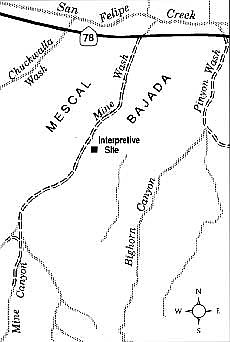 Facebook
Facebook
 X
X
 Instagram
Instagram
 TikTok
TikTok
 Youtube
Youtube
Tranquil Mine Canyon and its several tributaries slash deep into the Pinyon Mountains of central Anza-Borrego Desert State Park. Day after day, year after year, the parched ravines and boulder-splintered hillsides lie open to the searing rays of the sun. Once every several years rain pours in buckets out of the sky, and a fresh layer of sand, left behind by receding floods, coats the bottoms of the ravines and washes. Some of the water-borne sediment is carried down past the mouth of the canyon, where it accumulates on a broad, tilted alluvial plain, about four square miles in extent, known as Mescal Bajada. On this bajada (the Spanish word meaning "down-slope"), desert agave plants (a.k.a. century plants or mescal) grow in particular abundance.
The lack of heavy rain in the desert so far this season hasn't stopped some plants at Mine Canyon — desert lavender, for instance — from beginning their blooming cycles. Perhaps this is due to soaking by El Niño rains a year ago.
The road into Mine Canyon is an unpaved, sandy track not suitable for low-slung passenger cars. An Anza-Borrego parking permit, $5 daily or $50 annual, is required for exploration of this area. For information, call 760-767-4205 or 760-767-5311.

Drive 2.7 miles east of Tamarisk Grove campground on Highway 78, and turn south on the dirt road signed "Mine Wash." You work your way up the gently corrugated surface of Mescal Bajada 1.6 miles to a parking area and interpretive plaque, at the foot of a rocky ridge. Scattered amid the eroded granitic boulders and ironwood trees here you'll find old morteros, or mortar holes, a sure sign of prehistoric occupation by ancestors of today's Kumeyaay Indians.
As you drive farther along Mine Wash toward the Pinyon Mountains, notice how the vegetation changes from low-desert types such as the smoke tree, to agaves and later junipers. Pinyon pines, the namesake of the mountains, grow at still higher elevations.
There's a short spur road on the right at a major fork in the wash at 3.9 miles from Highway 78. This is an especially nice spot for car camping. From there, the road into Mine Canyon continues uphill a final 0.7 mile south-southwest, and a roadless fork of Mine Wash ascends gently south-southeast. The latter wash, along with its several branching tributaries, is wonderful to explore on foot -- especially when long shadows fall across the sands at the beginning and the end of each day. Stoic Mormon-tea shrubs poke up amid the rock rubble, bold specimens of teddy-bear and buckhorn cholla cactus glisten in the low-angle sunlight, and desert lavender exudes an ineffable perfume.

Tranquil Mine Canyon and its several tributaries slash deep into the Pinyon Mountains of central Anza-Borrego Desert State Park. Day after day, year after year, the parched ravines and boulder-splintered hillsides lie open to the searing rays of the sun. Once every several years rain pours in buckets out of the sky, and a fresh layer of sand, left behind by receding floods, coats the bottoms of the ravines and washes. Some of the water-borne sediment is carried down past the mouth of the canyon, where it accumulates on a broad, tilted alluvial plain, about four square miles in extent, known as Mescal Bajada. On this bajada (the Spanish word meaning "down-slope"), desert agave plants (a.k.a. century plants or mescal) grow in particular abundance.
The lack of heavy rain in the desert so far this season hasn't stopped some plants at Mine Canyon — desert lavender, for instance — from beginning their blooming cycles. Perhaps this is due to soaking by El Niño rains a year ago.
The road into Mine Canyon is an unpaved, sandy track not suitable for low-slung passenger cars. An Anza-Borrego parking permit, $5 daily or $50 annual, is required for exploration of this area. For information, call 760-767-4205 or 760-767-5311.

Drive 2.7 miles east of Tamarisk Grove campground on Highway 78, and turn south on the dirt road signed "Mine Wash." You work your way up the gently corrugated surface of Mescal Bajada 1.6 miles to a parking area and interpretive plaque, at the foot of a rocky ridge. Scattered amid the eroded granitic boulders and ironwood trees here you'll find old morteros, or mortar holes, a sure sign of prehistoric occupation by ancestors of today's Kumeyaay Indians.
As you drive farther along Mine Wash toward the Pinyon Mountains, notice how the vegetation changes from low-desert types such as the smoke tree, to agaves and later junipers. Pinyon pines, the namesake of the mountains, grow at still higher elevations.
There's a short spur road on the right at a major fork in the wash at 3.9 miles from Highway 78. This is an especially nice spot for car camping. From there, the road into Mine Canyon continues uphill a final 0.7 mile south-southwest, and a roadless fork of Mine Wash ascends gently south-southeast. The latter wash, along with its several branching tributaries, is wonderful to explore on foot -- especially when long shadows fall across the sands at the beginning and the end of each day. Stoic Mormon-tea shrubs poke up amid the rock rubble, bold specimens of teddy-bear and buckhorn cholla cactus glisten in the low-angle sunlight, and desert lavender exudes an ineffable perfume.
Comments